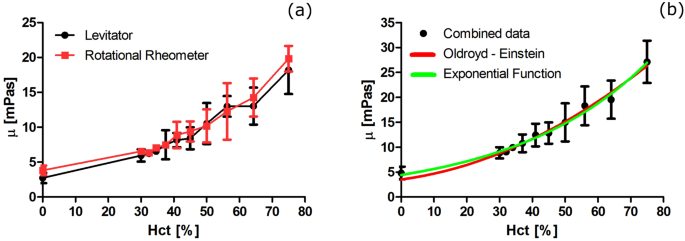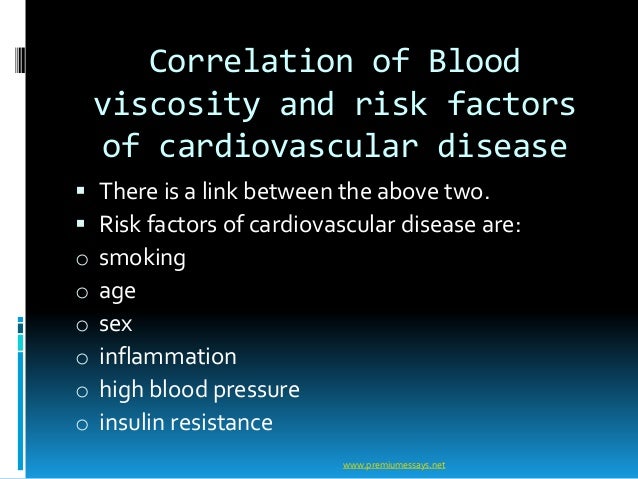

However, there is an exponential relationship between hematocrit and viscosity so that an. Mammalian blood with a normal hematocrit of 45 has a viscosity 2.4 times that of plasma alone. Plasma, devoid of cells and particulate matter, has a viscosity of 1.3 (pure water has a viscosity of 1). During the cooling process cells are exposed to increased levels of hypoxia because the oxyhemoglobin dissociation curve shifts to the left (i.e., less O 2 is released to the tissue). Apparent blood viscosity varies as hematocrit varies. Further, the study found no positive or negative association between high-intensity physical activity and subjective well-being, contradicting a widely reported recent study that found high-intensity workouts significantly lowered some people’s sense of well-being. Blood viscosity increases 2 for every drop in core temperature of 1 C, resulting in hematologic concentration and increased hematocrit (Danzl and Pozos, 1994). The work, published in the Journal of Health Psychology, found that people who led sedentary lives and engaged in light or moderate activity showed the greatest improvement in overall sense of well-being. More physical activity is not necessarily better when it comes to improving your mood, especially if you spend most of your day sitting, UConn and Hartford Hospital researchers found in a recent study. The developed physiometer is potentially applicable for a comprehensive analysis of biophysical indices in whole blood.Lifting Spirits Doesn’t Require Many Reps

By using this system, the temperature is controlled to 36.9 ± 0.2 ☌ which greatly matches with the target temperature (37.0 ☌) and it is varied from 25 ☌ to 43 ☌.
Blood viscosity software#
Lab-made software enables the measurement of the three target indices and the temperature control in an automated manner. A methylxanthine derivative used to treat intermittent claudication caused by chronic occlusive arterial disease of the limbs. For simultaneous and reliable measurement on a chip, a physiometer equipped with a temperature-control system is prepared. The effects of the hematocrit and RBC deformability on the whole blood viscosity are also demonstrated. In the deformability measurement, there is a strong linear correlation ( R 2 = 0.97) between the deformation index acquired by image processing and the change in the membrane capacitance acquired by using the physiometer.

For the hematocrit measurement, the coefficient of variation for the physiometer ranges from 0.3 to 1.2% which is lower than the one obtained from centrifugation. Elevated blood viscosity is a strong independent predictor of cardiovascular events. The whole blood viscosity measured using the physiometer is 0.8 ± 1.4% in normalized difference compared to that using a rotational cone-and-plate viscometer. Blood viscosity is correlated with all known risk factors for cardiovascular diseases. Each unique function is experimentally demonstrated and compared to the corresponding gold standard method. The hematocrit is estimated from R cytoplsm and R plasma, while the RBC deformation index is determined from the membrane capacitance change of the RBC. Like blood pressure, the viscosity of blood changes during each cardiac cycle and is reported using two numerical quantities: systolic and diastolic viscosity. In the electronic component, analysis of the whole blood impedance spectrum under flowing conditions reveals the electrical characteristics of the blood: the cytoplasm resistance ( R cytoplsm), plasma resistance ( R plasma), and RBC membrane capacitance (constant phase element). Blood viscosity holds certain similarities with blood pressure.
Blood viscosity series#
At a given flow rate, ten sets of whole blood viscosity readings are successfully obtained over a wide range of shear rates this is achieved via a series of geometrically optimized microchannel arrays. In the hydrodynamic component, the whole blood is infused with phosphate buffered saline as a reference fluid for estimation of the whole blood viscosity. The physiometer consists of two major parts: a hydrodynamic component for whole blood viscosity measurement and an electronic component for hematocrit and RBC deformability measurement.

In this study, a microfluidic-based physiometer capable of measuring whole blood viscosity, hematocrit, and red blood cell (RBC) deformability on a chip is introduced.


 0 kommentar(er)
0 kommentar(er)
